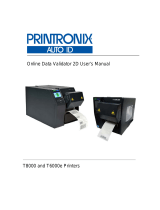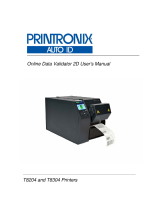Page is loading ...

Product Line Card
AutoVISION™ Verification Reports
Quick Reference
What is Verification/Grading?
Verication, sometimes referred to as grading, is the measurement of the quality of a
1D (linear) barcode or a 2D symbol such as Data Matrix, according to a standardized
methodology. The purpose of verication is to ensure that barcodes can be subsequently
read with the intended reading equipment.
International Quality Standards
There are two principal standards for 2D Data Matrix symbols. ISO 15415 is most applicable
to high contrast printed symbols, while the AIM DPM 2006 guidelines and ISO 29158
standard are designed for direct part marked (DPM) symbols. ISO 15416 (formally ANSI
X3.182-1990) is a standard that applies to 1D barcodes such as Code 128, ITF, and UPC,
and is the standard referenced in the GS1 General Specication.
AutoVISION Verification Reporting
AutoVISION software produces detailed verication reports based on three quality standards:
ISO 15415, ISO 15416, or AIM DPM/ISO 29158. Reports can be saved in either PDF or text
format. This guide explains how to interpret the specic information listed in the report, using
a 2D Data Matrix symbol and ISO 15415 as an example. ISO 15415 Verification Report
Symbol Contrast is the maximum difference in light reec-
tance between the light and dark regions of the symbol.
100 is the highest possible score.
The Final Grade is the overall quality of the
symbol. For ISO 15415 it is dened as the lowest
grade received for any measured parameter.
This data shows the grade reported per the ISO 15415 standard. In this example,
the nal grade in numeric form is 3 (B), the selected aperture is 8, the illumination
wavelength is 630 nm, and a 45 degree perpendicular light source is used.
Fixed Pattern Damage tests for missing elements or
distortions in the symbol’s quiet zone, nder pattern, or
clock pattern.
Axial Non-Uniformity is the amount of deviation along
the symbol’s major axes. A result of 3 indicates very little
axial non uniformity is present in the symbol.
Reference Decode uses the decode algorithm prescribed in the ISO
15415 standard. When the reference decode fails, the symbol cannot be
evaluated. The encoded data is also displayed.
Reflectance Margin measures how well each element of the symbol
is correctly distinguishable as light or dark in comparison to the global
threshold.
Modulation refers to the reectance uniformity of a symbol’s light and
dark elements.
Grid Non-Uniformity refers to the cell deviation from the theoretical or
“ideal” grid intersections to those that are determined by the reference
decode algorithm. It measures the maximum vector deviation from that
ideal grid.
Unused Error Correction Capacity indicates the amount of error
correcting capability remaining in the symbol. A score of 100 is ideal and
indicates no damage is present.

Product Line Card
AutoVISION™ Verification Reports
Quick Reference
www.microscan.com
Product Information:
info@microscan.com
©2014 Microscan Systems, Inc. ML040A 02/14
Technical Support:
Print Growth refers to the deviation (larger or smaller) of actual element
size from intended element size due to printing problems. Negative
numbers indicate black cells are printed slightly smaller than nominal.
Aperture states the size of the synthetic aperture used in the
verication process. The aperture is expressed in mils (1/1000 inch)
for a calibrated system, or in pixels for a non-calibrated system.
The Cell Size is measured in pixels. A symbol must have a minimum of
10 Pixels per Element (PPE) for consistent and reliable verication. On
calibrated systems, the size is shown in mils (1/1000 inch) or mm.
Symbol Size is measured in elements. 22 x 22 represents a size of 22
elements by 22 elements.
Symbol Type states the type of symbol used. For ISO 15415 this is
always Data Matrix ECC 200.
Target R Maximum shows the maximum reectance of the
symbol used for calibration. This corresponds to the reectance
of the white cells.
Target R Minimum shows the minimum reectance of the
symbol used for calibration. This corresponds to the reectance
of the black cells.
Width of Target Symbol 2 states the width of the widest symbol
on the calibration card.
Width of Target Symbol 1 states the width of the smallest
symbol on the calibration card.
State indicates whether or not the system is calibrated.
The image capture that is used in verifying the symbol is shown
below the Parameters sections and above the supplementary
information.
Supplementary Information
The rst items beneath the image capture are Aperture, Wavelength, and Angle. Aperture is stated again, this time in pixels.
Wavelength refers to the illumination LED output in nanometers. Angle states the angle of the illumination LEDs used in the
application. The Date and Time of the verication report are included, as well as any Setup Notes added by the operator. The
Software Version identies the version of AutoVISION software used at the time the report was created. The Device Name of the
smart camera, gigE camera, or emulator is also included.
Note: Please refer to additional resources such as Microscan’s verification white papers and the AutoVISION User Manual for information on other quality
standards, parameters, and AutoVISION Verification Reports.
/

